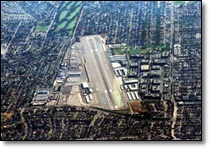 Plane Mufflers Could Relieve Some Airport Neighbors – Santa Monica Airport Commission responds to test results of a muffler that could be used by local flight schools.
Plane Mufflers Could Relieve Some Airport Neighbors – Santa Monica Airport Commission responds to test results of a muffler that could be used by local flight schools.
If flight schools take to the idea, attaching mufflers to some of their planes planes could make life more peaceful for residents living nearSanta Monica Airport.
The city tested a German-made muffler, called QuietFlight, on a Cessna 172 in December and recorded positive results, the Santa Monica Airport Commission learned Monday night (Calpilots Editor’s Note: Please read CalPilots Response to this article at the end of this page).
“You hear [the plane] coming toward you the same way, but it disappears once it moves past you,” said Stelios Makrides, the airport’s operations and noise management supervisor.
At its next meeting, the commission will consider asking the City Council to discount landing fees for aircraft that use mufflers.
See also: Tension Escalates Between Airport Commission, City
“In some parts of Europe, mufflers [are used as] incentives,” said John Fairweather, founder of a local advocacy group, Community Against Santa Monica Airport Traffic. “I think that’s what we should do in Santa Monica.”
City staffers are working on a proposal to charge landing fees to Santa Monica Airport-based aircraft. Currently, fees for landing at the airport are charged to aircraft not based at the airport. A nexus study assessing fees charged at other general aviation airports will be presented to the commission in February and to the City Council in April.
“The city has wide latitude in structuring its airport fees,” said Deputy City Attorney Ivan Campbell. “I don’t think the problem would be compliance… it would be whether or not it makes sense to the operators.”
The city estimated that of the approximately 30 flight school planes operating at the airport, the majority are Cessna 172s.
The cost of buying and installing a muffler is about $5,000 per plane, according to flight school owner Joe Justice.
“There wouldn’t be a mad rush to put those on to avoid paying landing fees,” he told Patch.
Airport staffers did two tests in December using the same Cessna 172 from Justice Aviation, one of six flight schools at Santa Monica Airport. On one day, the measured sound from the plane without the muffler, and on another—when weather conditions were nearly identical—they measured the noise with the muffler.
At a monitoring station on 18th Street, between Dewey and Navy streets in Santa Monica, they recorded a reduction in “single event noise exposure levels” between 4.8 dBA to 8.3 dBA. At the west end of Penmar Golf Course on Warren Avenue in Venice, there was a reduction between 3.5 dBA to 5 dBA.
The duration of the noise decreased, too, Makrides wrote in a report. At the Santa Monica station, there was a reduction of between 2 to 6 seconds (or about 17 to 46 percent), and at the Venice station between 4 to 9 seconds (or approximately 33 to 56 percent).
“It goes without saying that an 8.3 dBA reduction in SENEL for the normal ‘fly neighborly’ departure path could truly be a game changer in terms of mitigating neighborhood noise impacts from prop planes,” Community Against Santa Monica Airport Traffic wrote Sunday on its website.
CASMAT said the muffler has the potential to “get rid of the continuous lower level droning of pattern flying for all neighborhoods in the pattern flying loop, as well as reducing the impact of the actual takeoff overpass for the observer.”
Michele Perrone questioned whether the muffler would actually help residents in Santa Monica’s Ocean Park neighborhood. “Most of our noise is coming at us,” she said. “Maybe it’s not going to help us.”
About 40 percent of Santa Monica Airport traffic is generated by aircraft that stay within the local traffic pattern or the airport’s designated controlled airspace, and many of those operations are takeoffs and landings by pilots-in-training, according to Airport Services Director Robert Trimborn.
“Airport staff receives numerous noise complaints from residents regarding these repetitive types of local operations especially during weekends and holidays when most people are at home,” Trimborn said in June, when the council considered paying pilots to conduct training flights at other Los Angeles-area airports.
“It does seem like flight schools are becoming more and more prominent in the discussion and recommendations we’re making,” commissioner Ofer Grossman said Monday night.
Related Topics: Airport Commission, SMO, and Santa Monica Airport
CalPilots’ Response to the article –
Aircraft muffler(s) do play a role regarding noise on propeller aircraft, but not typically as much as the propeller(s) does.
The majority of prop-aircraft noise comes from the propeller tips approaching sub-sonic speed at high RPM, which is required for takeoff. The longer the prop the more noise it generates, dependent upon RPM numbers. Lower horsepower aircraft such as training C172’s are not the problem.
Aircraft will never be as quiet as automobiles, so asking aircraft owners to invest in some ridiculously priced muffler will not make a significant difference.
If there was any type of aviation expertise on the airport board they would know this and not waste everyone’s time chasing “silver bullets”. But then, I suppose that is what these politico type’s do.
Ed Rosiak – California Pilots Association
